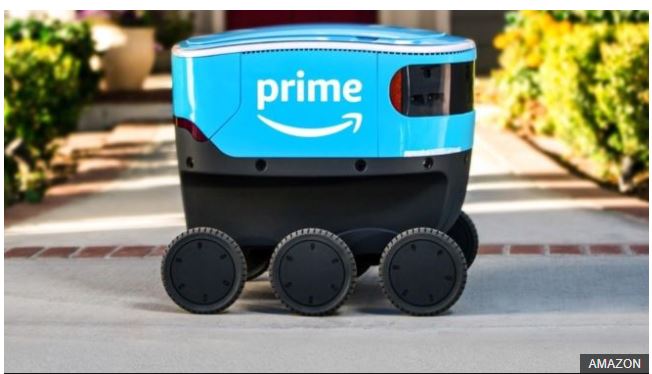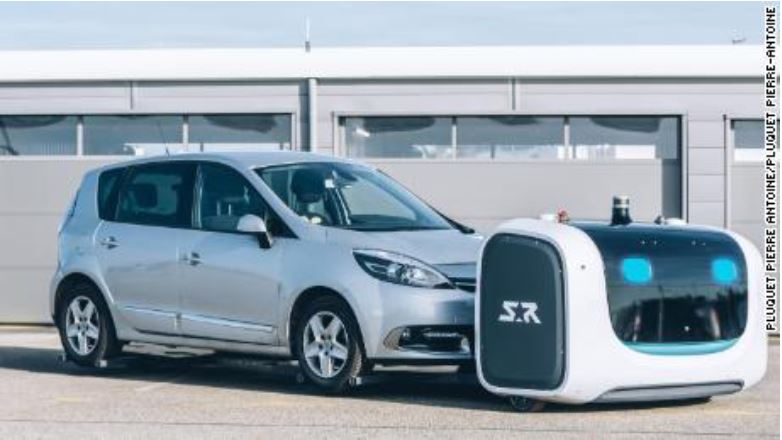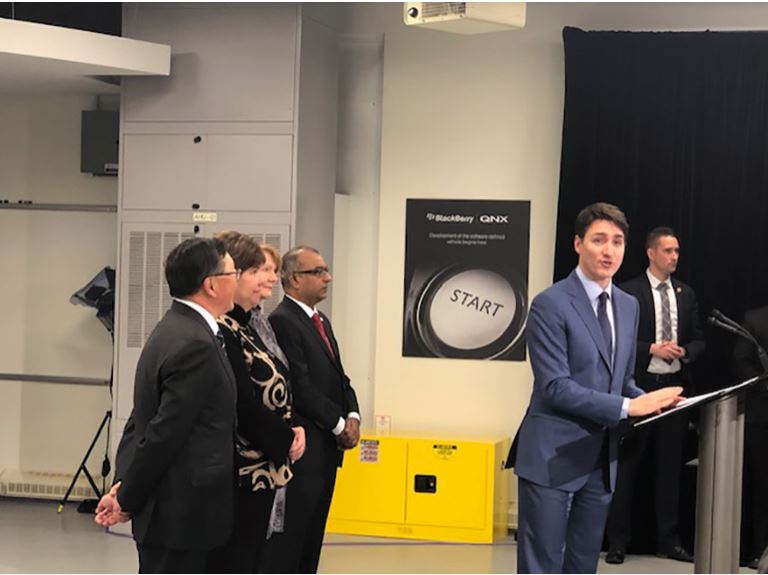From the Editors
Canadian AV News In a big boost for Canadian CAV development, a 1,866-acre test facility in suburban Ottawa will be officially launched in a few weeks. The Federal Government, Ontario and Ottawa are alll stakeholders in the project. Day-to-day management is spearheaded by Invest Ottawa, the City of Ottawa’s economic development arm. The test bed, dubbed Ottawa L5 (site here), has 16 Km of track for testing communication technologies (including 5G) for connected and automated vehicles as well as a 5.2-km high speed test loop according to plans on Ottawa L5’s website. Major companies such as Nokia, Ericsson, Blackberry QNX, Juniper Networks and IBM will be conducting R&D at this facility. More information is at this link. CAVCOE's Barrie Kirk was interviewed by the CBC regarding his views on the Ontario Government’s announcement on January 22, 2019 to allow testing of vehicles with no-one in them and truck platooning on Ontario’s public roads. Barrie was supportive of this initiative and called it a step in the right direction. Barrie also maintained that the deployment process with be a gradual one. The new rules modify Ontario's 10-year automated vehicle pilot program that was launched in 2016. More information is at this link. On a somewhat related matter, the National Post reported on February 13, 2019 that Huawei has leveraged machine learning, sensors, advanced image and speech processing to determine if a driver is capable of driving a vehicle or can override a self-driving or driverless vehicle. The article states that nine companies in Canada are engaged in driverless vehicle R&D. Among them are BlackBerry QNX, Magna, Uber and the University of Waterloo. More information at this link. On February 8, 2019, consulting firm KPMG released its second annual report on ‘Autonomous Vehicle Readiness Index’ (AVRI). This index assesses AV readiness of various countries based on 25 different criteria. Sadly, Canada’s ranking has dropped from 7th place in 2018 to 12th place in 2019. The #1 country is The Netherlands, for the second year running. Whereas 20 countries were assessed in 2018, this year 25 countries were evaluated. New entrants are the Czech Republic, Hungary, Finland, Israel and Norway. More information and copy of the report can be found at this link. The ‘Policy and Planning Support Committee’ (PPSC) Working Group made up of representatives from Canadian Council of Motor Transport Administrators (CCMTA), Engineering and Research Support Committee and the Transportation Association of Canada (TAC) presented a report to the Council of Ministers of Transportation and Highway Safety in January 2019. The 26-page report titled Automated and Connected Vehicles Policy Framework for Canada lays out the fundamental groundwork necessary for development of CAV technologies in Canada and defines roles and responsibilities of the various levels of government. A copy of the report can be downloaded from this link. International AV News Waymo, the self-driving car arm of Google, is planning to set up a factory in Michigan entirely dedicated to producing self-driving cars. Michigan’s historical role in auto manufacturing was one reason for choosing this state over others. The new plant is expected to create up to 400 new jobs. Waymo will invest $13.6 million to retrofit a to-be-determined manufacturing facility in the Detroit area. The state of Michigan offered Waymo an incentive grant worth up to $8 million. More information is at this link.The UK edition of the AutoTrader has published a primer on self-driving cars explaining the basic concepts of how a self-driving car works, levels of automation, insurance issues, the main players in AV space, etc. Of note is a list of 32 vehicles that AutoTrader lists as having some built-in level of automaton. The AutoTrader article can be viewed at this link. Most people think of Amazon as a giant online retailer. While this is true, Amazon is also one of the world’s largest logistics companies employing all modes of transportation for its distribution and delivery network. As of late, this includes autonomous delivery robots. Back in 2017, Amazon quietly acquired a small San Francisco based technology company called Dispatch. Some of the technologies developed by Dispatch are now incorporated into Amazon’s delivery robots dubbed Scout which were used in a pilot project in January 2019 in Snohomish County in Washington State. More information is at this link.  Along the same theme, the UK’s Starship Technologies has started parcel, grocery and food deliveries using autonomous robots. The 6-wheeled robots have 10 cameras, ultrasound sensors, radar, and GPS to help them navigate. The company has been actively delivering groceries in Milton Keynes since October 2018. The service is available through a mobile phone app. Subscribers pay a monthly fee of £7.99 for an unlimited number of deliveries. More information is at this link. Staying with the delivery robot theme, there are times when things don’t quite go right with autonomous delivery robots. Case in point is a delivery robot made by Kiwibot which caught fire while delivering food at the UC Berkeley campus in December 2018. Kiwibot had been delivering food on this campus for the past two years. More information and photo at this link. And a different kind of autonomous robot is being tested by the UK’s Gatwick Airport for parking visitors' cars at that airport. The robot named Stan uses forklift-like arms and artificial intelligence to create up to 50% more space in a parking lot. Report and video from CNN is at this link.  In line with many other countries, France has realized the importance of AVs and has developed a national framework and roadmap for the development of this technology. The French approach has three major thrusts: safety, demonstration projects and collaboration. The safety framework will be completed by 2020-2022 and will cover all types of vehicles with emphasis on public transport autonomous solutions. Copy of the 96-page report (in French) titled Développement des Véhicules Autonomes - Orientations stratégiques pour l’action publique can be downloaded from this link. Simulation is an essential part of development in many areas of science, engineering and technology. This includes both connected and autonomous vehicles. The UK firm rFpro has developed advanced simulation software for autonomous vehicles to test and evaluate all kinds of scenarios in many different settings and environments. The technology is derived from many years of work in the gaming and special effect industries. The process is very data hungry typically requiring 32 GPUs and 32 CPUs for a single experiment and producing some 500GB of data per second. More information is at this link. Zenuity is an autonomous vehicle joint-venture between Volvo and its partner Veoneer. Recently, Zenuity was successful in obtaining approval from Swedish authorities for testing its Level 4 AVs on Sweden’s public roads. In Level 4 mode, there is no need to have a hand on the steering wheel because -- as the article points out -- successful Level 4 vehicles have the capability of completing a trip from point A to point B on most roads without any human touch. One restriction that the Swedish authorities gave imposed in Zenuity is that its test vehicles cannot exceed a speed of 80 Km/h. More information is at this link. The UK’s Department for Transport (DfT) has made amendments to its regulations to allow autonomous vehicles with no driver to be tested on public roads. DfT has stipulated that the new regime will be subject to “rigorous safety assessments”. The UK’s market for CAVs is estimated to be worth £52 billion by 2035. More information at this link. Automation is not limited to ground vehicles. In Finland, automation technology developed by Rolls-Royce has been applied to ferries to make them autonomous. In an emergency, the ferry can be controlled by humans from dry land using satellite and internet communications. More information and video are at this link. Money flows into autonomous vehicle development unabated. One of the latest funding rounds was by self-driving startup Aurora, which was founded in 2016 by Chris Urmson (formerly with Google) and Sterling Anderson (formerly with Tesla). It was announced on February 7, 2019 that Aurora has secured a $530 million investment from Amazon, Sequoia, and others. Aurora has partnerships with partnerships with Volkswagen and Hyundai among others. More information is at this link. In a similar move, it is reported that Japan’s SoftBank is investing $940 million into Nuro, a Silicon Valley startup developing robotic delivery vehicles. This is one of the largest such investments for automated vehicles. Trucking and logistics are an increasingly an important area of autonomous technology development as the deployment of driverless systems for passenger vehicles is looking more challenging than some advocates initially anticipated. More information at this link. 
And sticking with the funding theme,
TuSimple
- a U.S.-Chinese tech startup engaged in commercializing
self-driving capability for long-haul semi-trucks, is
reported to have reached the Unicorn status with its latest
round of funding for $95 million. The Unicorn status is for
firms achieving a valuation of
$1 billion.
More information is at
this link. And finally, the January 2019 edition of Harvard Business Review (HBR) had an article on the economic side of self-driving cars. The article focused on whether lower income people will be better off using a shared self-driving cars (robotaxis) versus owning an older personal vehicle. To see the analysis and conclusion of Harvard researchers, check the article at this link. Feb 28 – March 1, 2019: Operational Safe Systems for Level 5 Automation (OSS5), South San Francisco Conference Centre Mar 11-12, 2019: Tech AD, Berlin, Germany. April 8-9, 2019: Autonomous & Connected Vehicle Europe 2019, Berlin, Germany April 28 – May 1, 2019: IEEE Vehicular Technology Conference, Kuala Lumpur, Malaysia
May 8-9, 2019:
IoT613
Conference, Gatineau, Quebec May 21-23, 2019: Autonomous Vehicle Test & Development Symposium Europe, Stuttgart, Germany
June 2-5, 2019:
Canadian Institute of Transportation Engineers (CITE) annual
conference at the Westin hotel in Ottawa
Sept 9-10, 2019:
CAV
Canada 2019, a national CAV conference organized by the
Kanata North Business Association, Invest Ottawa and the
Canadian Automated Vehicles Institute (CAVI); Brookstreet Hotel,
Ottawa Sept 22-25, 2019: IEEE Vehicular Technology Conference, Honolulu, Hawaii Oct 2019: World Congress and Challenge for Self-Driving Transport, Dubai, UAE Oct 21-25, 2019: ITS World Congress, Singapore
Jan 7-10, 2020
CES 2020,
Las Vegas, Nevada |
||||||
|
AV Update
is a free, monthly roundup of news and analysis in the world of
automated vehicles and their impact on all levels of government
and the private sector. 300 Earl Grey Drive, Suite 222, Ottawa ON K2T 1C1, Canada. info@cavcoe.com www.cavcoe.com |
